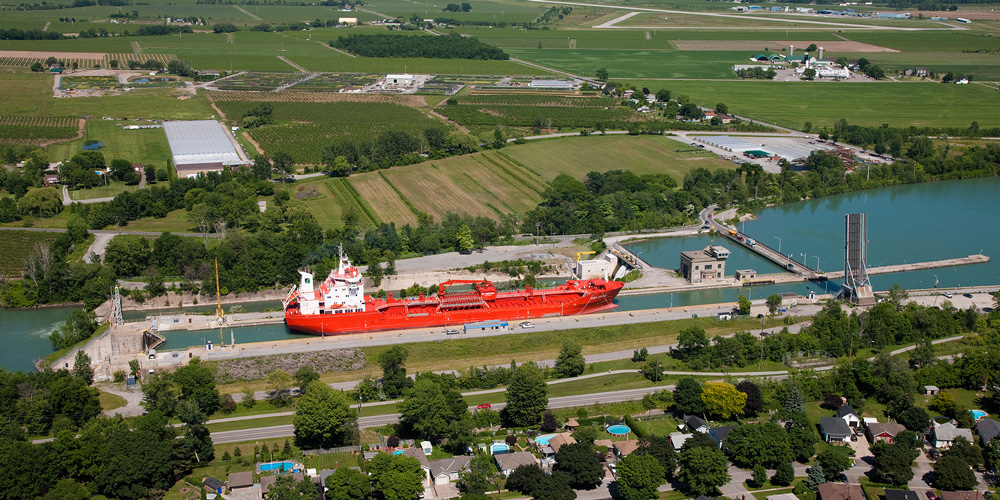Seaway Corporations Lead Binational Trade Mission to China
April 21, 2006
St. Catharines, Ontario, April 21, 2006 — The leaders of the Canadian and U.S. St. Lawrence Seaway Corporations depart today with a delegation of 20 senior marine industry officials from the Great Lakes St. Lawrence Seaway System on a weeklong trade mission to China. The delegation will be promoting new business partnerships in Beijing, Shanghai, Hong Kong, and Shenzhen and touring shipping facilities. They will also be meeting with high-level government officials and key industry leaders to build the relationships that are critical for business success in China.
The transportation demands created by Chinese economic growth have caused unprecedented congestion at major North American coastal ports. Consequently, these delays have forced shippers and brokers to explore alternative transportation routes to facilitate Chinese waterborne trade. The primary purpose for the increased focus on China is to create awareness of the Great Lakes St. Lawrence Seaway System as an alternative route into North America’s heartland and to highlight its ability to provide capacity to this growing market.
A meeting last year between Seaway Corporation officials and representatives from the Chinese Ministry of Communications, Water Transport Division revealed a mutual desire to enhance cooperation in marine transportation. This meeting resulted in an agreement to develop a cooperative plan targeting further exchange of technology, marketing and water management information. The agreement is scheduled to be signed Monday in Beijing and will be followed by a meeting with COFCO, China’s largest state-owned importer of food products.
Delegates then fly to Shanghai where the Seaway Corporations’ Hwy H2O Port Partners Program will enter into an agreement establishing a ‘Sister-Ports Affiliation’ with the Port of Shanghai. The agreement is designed to strengthen and promote trade and maritime business and calls for exchanges in the areas of harbour development, port management, and vessel standardization. The signing of this agreement will be followed by a marine industry seminar, hosted by the Great Lakes Seaway delegation, involving carriers, shippers and port operators.
While in Shanghai, the trade mission delegates will meet with top executives from the port, China Ocean Shipping Co. (COSCO) and China Shipping Container Lines to continue discussions on easing coastal freight congestion by increasing shipping calls to the Port of Halifax. The Great Lakes Seaway ports are eagerly encouraging feeder service movements into the North American heartland through the Halifax hub.
Seaway delegates will also tour Shanghai’s Yangshan Deep Water Port, a multibillion dollar port located 20 miles east of the city in the South China Sea. Connected to the Yangtze River port by a causeway with rail connections, Yangshan’s five container berths are projected to increase capacity sixfold to 30 berths upon project completion in 2012. Yangshan port officials claim that the completed project will allow the port to handle 20 million TEUs annually.
Hong Kong marks the next stop for the delegates. They will meet with Hutchinson Port Holdings and members of the Hong Kong Shipowners Association, as well as tour the port facilities. Discussions will center on bulk and container cargo shipments to North America, and the potential for increased shipments through the Seaway on smaller vessels. The delegation will then travel to the city of Shenzhen, located in the south of the Pearl River Delta, adjacent to Hong Kong, to meet with port and government officials. As one of the leading container ports in the world, the Port of Shenzhen handled over 14 million TEUs in 2005.
“Seaway Trade Missions promote Great Lakes St. Lawrence Seaway System commodities and the excellent marine services our ports and terminals provide customers,” said Richard Corfe, President & CEO of the Canadian St. Lawrence Seaway Management Corporation. “This mission to China provides a unique opportunity to deliver firsthand the message that our inland waterway system has unused capacity and is an affordable, reliable, and immediate solution to the increasing congestion at coastal ports. Using feeder vessels, the St. Lawrence Seaway can readily bring containers right into the heart of the continent.”






